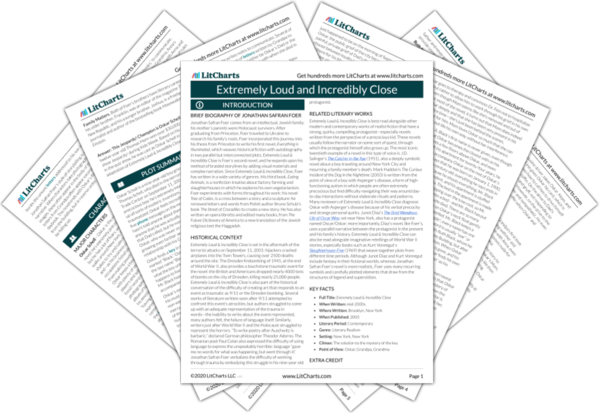Summary
Analysis
This chapter is set in 1963, so Oskar must no longer be the narrator. (The reader doesn’t know it yet, but the narrator is Oskar’s Grandpa.) The chapter is written in the form of a letter that begins, “To my unborn child.” The narrator tells the reader about losing his ability to speak: he loses words one by one, starting with the word “Anna”; the last word he was able to speak aloud was “I.”
Jonathan Safran Foer doesn’t tell the reader who’s writing this letter, but soon, enough details come together to show that it’s Grandpa. Grandpa has a very different style of narration than Oskar. Grandpa writes in very long sentences, separated by commas, and doesn’t break his writing into paragraphs, whereas Oskar constantly jumps from idea to idea.
Themes
To communicate, Grandpa has the word “YES” tattooed on his left palm and “NO” tattooed on his right. He carries a blank book to fill with all the things he couldn’t say aloud, and by the end of the day, he had usually run out of pages.
Grandpa’s post-traumatic stress disorder after Dresden has left him unable to speak, but that doesn’t mean he doesn’t understand and can’t communicate. One aspect of language has failed him, but he can still find some ways to communicate.
Themes
Then, the reader is presented with several examples of pages from these blank books: each page has only one word or phrase on it, such as “I’m sorry, this is the smallest I’ve got,” “I’m not sure, but it’s late,” or “Ha ha ha!”. The letter resumes after a few of these blank pages, and Grandpa describes the hundreds of stacks of these daybooks that have accumulated all over his apartment. Jonathan Safran Foer, the author, also includes a photograph of a doorknob here.
Instead of just writing about something, Jonathan Safran Foer often breaks the narration to insert an actual example of the thing described. The blank spaces around the phrases create a different effect than just reading about them: the reader gets the direct experience of the books, rather than those books filtered through the language of description.
Themes
When Grandpa met the mother of the “unborn son,” he had already lost the ability to speak. They discuss loss and canned tuna––or, rather, the woman speaks, and Grandpa shrugs and responds through gestures and some brief written notes.
By the time Grandpa has met Grandma, he’s already become his traumatized, silent self. He can communicate, and he can even joke, but he can’t engage in real back-and-forth conversation.
Themes
Get the entire Extremely Loud and Incredibly Close LitChart as a printable PDF.

The woman (Grandma) asks the writer of the letter (Grandpa) why he doesn’t speak, and the narrator writes, “I don’t speak. I’m so sorry.” The woman writes on the final blank page of the daybook, “Please marry me”. (Jonathan Safran Foer puts this page right into the book itself.)
Writing in Grandpa’s notebook is as intimate an action as kissing him: the notebook is how he communicates with the world, and Grandma connects with him by inscribing herself into his life.
Themes
Grandpa flips back to several phrases in the daybook–– “Ha ha ha!” and “I’m sorry, this is the smallest I’ve got” and “I’m not sure but it’s late”––but the woman will not budge. He thinks about everything he has lost in his life, flips back slowly through the notebook, and places her finger on a page that says, “Help” (which Foer inserts into the chapter).
Despite the fact that they can’t communicate in a typical way, Grandpa and Grandma connect with each other and forge a bond through single words and gestures. Grandma and Grandpa both need each other’s help.
Themes












